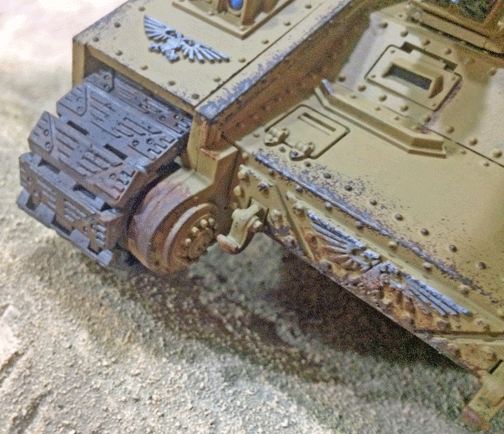
The “Nemesis,” a Baneblade superheavy tank assigned to the 002nd Tallarn Regiment.
I’ve just completed my largest—and best—painting project of my life, and I’m “tickled pink.” So, please humor me as I show off my new Baneblade. It’s named “Nemesis.”
I found this large model—in an unopened box—at the flea market of a local hobby convention. The owner wanted it to have a good home and was selling it for only $50.
I was more than happy to bring this poor puppy home with me.
While I’m hardly ready to win a Golden Sword, I recognized that a Baneblade is a showcase model—and I needed to “up my game” when I painted it. So, I gave it a shot.

I tried to add sufficient weathering to make this vehicle look as if it’s been in constant action . . . but not ridiculously so.
Much of the paint job was my standard paint-by-the-numbers work. As my Baneblade will be part of my small-but-growing Tallarn force, I went for a desert theme—and selected Tallarn Yellow as the base color.
I broke up the yellow with various colors on the details. Leadbelcher was used on some piping, while the fuel drums were Castellan Green. I had added a few details, such as shovels and chains, and they were painted appropriately as well.
Where I varied from past projects was in the weathering, and, man, I was nervous about trying it. I really didn’t want to ruin my model. But I knew I had to attempt to “bring it to life.”
My first step was a technique I’d read in one of Games Workshop’s painting guides. Using a sponge, I dappled Rhinox Hide along the tank’s edges, followed by a lighter dappling of LeadBelcher.
This produced a nice, weathered look to the model, suggesting the hull paint had been stripped away by sun, rain, gravel, and troops climbing all over it.

I think there’s just enough detail work to break up the solid Tallarn Yellow hull color.
I was tempted to paint the treads with a very thick coat of Agrelland Earth or Armageddon Dunes, one of Citadel Paint’s texture paints. If you mix in flocking, you can make your treads look as if they’re caked in mud.
But I wanted a desert theme, so I didn’t think the appearance of mud or turf was the way to go. As for Armageddon Dunes, I was concerned that a lighter, sandy color might not stand out well against the Tallarn Yellow (a small application proved me correct).
So, what I went for was a thin coat of Stirland Battlemire—just enough to give a sense of dirt ground into the treads and splattered along the lower hull. I the dry-brushed those areas with a lighter color to offer some contrast and texture.
The result was not exactly the colors that would be found on a tank that’s operating in the desert. But, to the hobbyist’s eye, particularly on a standard grass mat, the darker colors stand out better and are more “natural” to what people expect (since most live in temperate areas).

A look at the ID colors, decals, and dirty lower hull of the tank.
Sometimes painting what people’s expect to see works better than realism.
What really brought all of this effort together was what came next: I used Thypus Corrosion, what Games Workshop calls a “technical paint,” on parts of the hull where corrosion would be found. I also added some rust streaks down the side of the hull.
Finally, in what I found was the scariest part of the weathering process, I liberally coated the hull with washes of Nuln Oil and Agrax Earthshade.
What really brought all this together was what came next. I used Typhus Corrosion, a what GW calls a “technical paint,” on the hull where corrosion would appear, and then I added some dust streaks (don’t know the color) down the side of the hull.
I wasn’t sure I’d pulled this project off until everything dried. The end result was very impressive (at least compared to my previous painting efforts). I have no doubt, on close inspection, an expert painter would note that my mud, dust, and corrosion might not be as realistically portrayed as it might.
But, on the tabletop, the model looks fantastic—and I’m more than happy with it.

On the upper hull, the weathering is more limited—mostly along sharp edges.
Alas, I didn’t realize until too late that a Shadowstorm’s Volcano Cannon isn’t mounted on a turret—it’s a hull-mounted gun.
Whoops. Ah, well, while I may not be able to use the model as a Shadowstorm at a tournament, I can tell The Gaffer that the long gun is an experimental prototype with the same power as a Volcano Cannon—and we’ll treat the turret mechanism as inoperable. That’s close enough.
Hey, this is about having fun, right?—TheGM
—
The Corvus Cluster is a Warhammer 40K blog documenting our gaming adventures in the fantastical sci-fi universe of Games Workshop.
Categories: Painting

Nice paint job, don’t know how the volcano cannon would have looked hull mounted. This looks good just the same.
LikeLike
Cracking job mate, well done! Still working on my sponge chipping,not quite cracked it yet but yours looks awesome 😀
LikeLike
magnificent put up, very informative. I’m wondering why the opposite experts
of this sector don’t notice this. You should continue your
writing. I’m confident, you’ve a great readers’ base already!
LikeLike